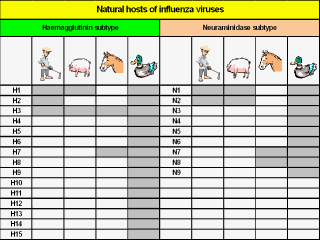| front |1 |2 |3 |4 |5 |6 |7 |8 |9 |10 |11 |12 |13 |14 |15 |16 |17 |18 |19 |20 |21 |22 |23 |24 |25 |26 |27 |28 |29 |30 |31 |32 |33 |34 |35 |36 |37 |38 |39 |40 |41 |42 |43 |44 |45 |46 |47 |review |
 |
Influenza A viruses are found in many different
animals, including ducks, chickens, pigs, whales, horses, and seals. There are 16 different haemaglutinin subtypes and 9 different neuraminidase subtypes, all of which have been found among influenza A viruses in wild birds. Wild birds are the primary natural reservoir for all subtypes of influenza A viruses and are thought to be the source of influenza A viruses in all other animals. Most influenza viruses cause asymptomatic or mild infection in birds; however, the range of symptoms in birds varies greatly depending on the strain of virus. Infection with certain avian influenza A viruses (for example, some strains of H5 and H7 viruses) can cause widespread disease and death among some species of wild and especially domestic birds such as chickens and turkeys. Pigs can be infected with both human and avian influenza viruses in addition to swine influenza viruses. Infected pigs get symptoms similar to humans, such as cough, fever, and runny nose. Because pigs are susceptible to avian, human and swine influenza viruses, they potentially may be infected with influenza viruses from different species (e.g., ducks and humans) at the same time. If this happens, it is possible for the genes of these viruses to mix and create a new virus. |